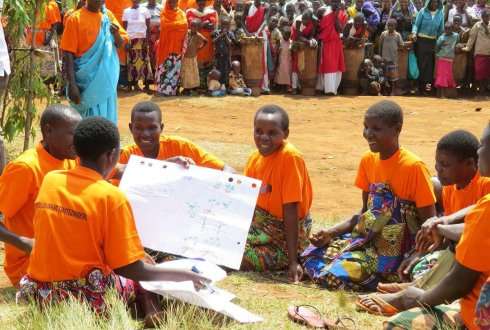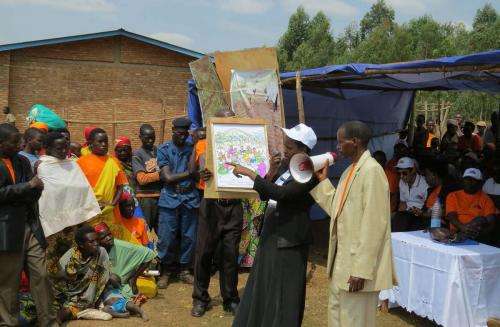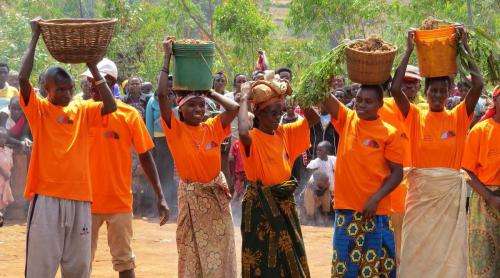The basic idea behind the project is explained in a sketch: the integration of health, agriculture, micro-credits and micro-insurance as the foundation for an Integrated Farm Plan (Plan Integre de Paysan = PIP).
In July, an open day was held in the village communities of Makebuko and Bukirasazi in Burundi. The aim was to demonstrate the success of SCAD, a collaborative project set up by Alterra, Achmea and HealthNetTPO, which employs an integrated approach to improve both the food production and the social security of the local population.
The SCAD project (projet de Solidarité Communautaire pour l'Auto Développement) was officially launched last September, with Alterra providing the expertise in agriculture and soil and water management, Achmea in micro-credits and insurance, and HealthNetTPO in healthcare. The first results were presented on the open day. The whole village and the local officials turned out for the event and witnessed the success of the project at first hand.
Higher yields and better quality food
"Whereas, in the past, a farmer needed around 30 kilos of seed to plant a field, he can now plant the same field with just nine kilos of improved seed, and even increase his harvest," says Alterra project leader Niek van Duivenbooden. "Drawing up an 'Integrated Farm Plan' and showing the benefits of different farming methods already goes a long way to giving farmers higher expectations for the future and the means to achieve them. This plan is designed to raise the quality of the food as well as the yield and will ultimately improve the health of the farmers. A healthy farmer is a productive farmer."
Knowledge transfer via innovative farmers
Left: potatoes grown by a traditional farmer. Right: potatoes grown by an innovative farmer.
The project owes much of its success to the knowledge contributed by researchers and – perhaps even more so – to the way the changes are implemented. The farmers themselves are key drivers of the improvements. The first step was to form a group of around 80 'innovative farmers' and train them in an integrated approach to food production and some new techniques. The members of this group then shared what they had learned with more than 1,000 fellow-farmers in their own community and thus paved the way for the formation of cooperatives that would enable them to produce more for the market. The required inputs (fertiliser, seeds, insecticides) could be purchased via micro-credits. The scientific underpinning for improving production and sustainability came from Niek van Duivenbooden, Aad Kessler and other experts via the local team.
Project goes beyond agriculture
An innovative farmer uses a box of sketches to show neighbouring farmers how to make an Integrated Farm Plan and how to apply for micro-credit.
On the open day the innovative farmers presented the results not just in the conventional manner by holding demonstrations in their own fields and printing posters and photos, but also by staging a comic sketch, which showed that there is a lot more to the project than improved agricultural techniques. The audience found out that if a farmer took ill, he could still continue to farm thanks to insurance and a micro-credit. Niek van Duivenbooden comments, "The farmers make the villagers aware that a secure existence depends on a lot more than just sowing seeds and hoping for a good crop. It takes collaboration and, where necessary, insurance and micro-credits combined with improved methods and techniques to assure farmers of a more secure existence in the future. At the moment the project embraces a fairly limited group, but it has been such a success that we intend to up the pace and reach many more farming communities. I have been particularly struck by the farmers' own determination to progress. Our job is mainly to facilitate a development process that is borne by the local population."
The anticipated result: baskets filled with food for domestic consumption or to sell at the market.
Provided by Wageningen University
























